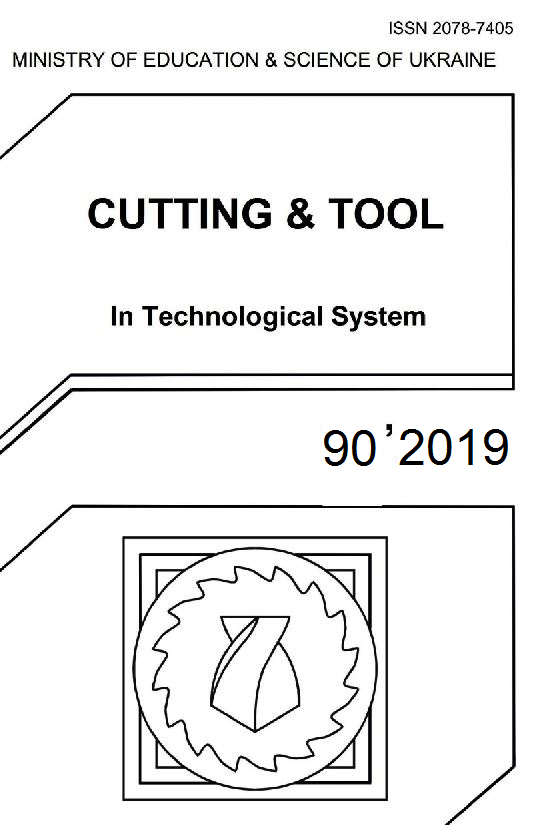INFLUENCE OF DEPTH OF CUT AND CUTTING SPEED ON CUTTING FORCES IN FACE MILLING UNDER CONSTANT CHIP CROSS-SECTION CONDITIONS
DOI:
https://doi.org/10.20998/2078-7405.2019.90.02Keywords:
face milling, cutting forces, specific cutting forces, chip cross-section.Abstract
In various high-end industries such as the automotive and the aerospace industry, face milling is one of the most preferred solutions for the fabrication of flat surfaces with high quality. During machining it is desired to achieve the required result with high efficiency. However, attention should be paid so that forces are kept within acceptable limits for maintaining energy consumption and loading of machine tool at relatively low levels. Thus, it is important to determine the influence of process conditions, such as depth of cut or cutting speed, on cutting forces. In this study, this is attempted by conducting experiments at two different depths of cut and four different cutting speeds for cases with the same chip cross-section value. After analysis of obtained results, useful conclusions on the influence of these parameters on cutting forces are presented.References
Kundrák, J., Makkai, T., Markopoulos, A.P.: Investigating the impact of feed and cutting speed on cutting forces for the increase of surface removal rate in face milling, Cutting & Tools in Technological Systems: NTU ‘KhPI’ 87, pp.126-132.
Kundrák, J., Makkai, T., Deszpoth, I., Nagy, A.: Investigation of cutting force in face milling, Cutting & Tools in Technological Systems: NTU ‘KhPI’ 87, pp.118-125. (2017).
Kundrák, J., Markopoulos, A.P., Makkai, T., Deszpoth, I., Nagy, A.: Analysis of the effect of feed on chip size ratio and cutting forces in face milling for various cutting speeds, Manufacturing Technology 18(3), pp. 431-438. (2018).
Čekić, A., Begić-Hajdarević, Đ., Kulenović, M.: Effect of the cutting parameters on cutting forces in high speed face milling, Tehnički Vjesnik 20(5), pp.775-780. (2013).
Subramanian, A.V.M., Nachimuthu, M.D.G, Cinnasamy, V.: Assessment of cutting force and surface roughness in LM6/SiCp using response surface methodology, Journal of Applied Research and Technology 15, pp. 283-296. (2017).
Kaya, E., Akyüz, B.: Effects of cutting parameters on machinability characteristics of Ni-based superalloys: a review, Open Engineering 7, pp. 330-342. (2017).
Ghani, J.A., Choudhury, I.A., Hasan, H.H.: Application of Taguchi method in the optimization of end milling parameters, Journal of Materials Processing Technology 145, pp. 84-92. (2004).
Malghan, R.L., Rao, M.C.K., Arun Kumar, S., Rao, S.S., D’Souza, J.: Effect of process parameters in face milling operation and analysis of cutting force using indirect method, Materials and Manufacturing Processes 33(13), pp. 1406-1414. (2018).
Kilickap, E., Yardimeden, A., Çelik, Y.H.: Mathematical modelling and optimization of cutting force, tool wear and surface roughness by using artificial neural network and response surface methodology in milling of Ti-6242S, Applied Sciences 7, 1064. (2017).
Subramanian, M., Sakthivel, M., Sooryprakash, K., Sudharakan, R.: Optimization of cutting parameters for cutting force in shoulder milling of Al7075-T6 using response surface methodology and genetic algorithm, Procedia Engineering 64, pp. 690-700. (2013).
Yalcin, U., Karaoglan, A.D., Korkut, I.: Optimization of cutting parameters in face milling with neural networks and Taguchi based on cutting force, surface roughness and temperatures, International Journal of Production Research 51(11), pp. 3404-3414. (2013).
Downloads
Published
Issue
Section
License
Copyright Notice
Authors who publish with this Collection agree to the following terms:
1. Authors retain copyright and grant the Collection right of first publication with the work simultaneously licensed under a Creative Commons Attribution License that allows others to share the work with an acknowledgement of the work's authorship and initial publication in this Collection.
2. Authors are able to enter into separate, additional contractual arrangements for the non-exclusive distribution of the Collection's published version of the work (e.g., post it to an institutional repository or publish it in a book), with an acknowledgement of its initial publication in this Collection.
3. Authors are permitted and encouraged to post their work online (e.g., in institutional repositories or on their website) prior to and during the submission process, as it can lead to productive exchanges, as well as earlier and greater citation of published work.

